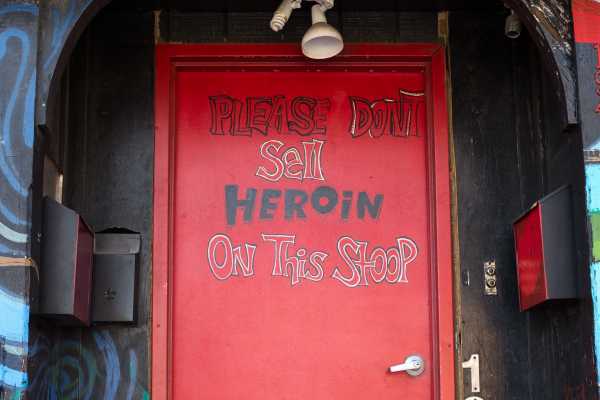
Friday is International Overdose Awareness Day, a time to raise awareness and combat stigma related to drug overdose and addiction. But the day is particularly relevant in these times, as America deals with its deadliest drug overdose crisis in its history in the opioid epidemic.
According to preliminary data from the Centers for Disease Control and Prevention, 2017 was the worst year for drug overdose deaths in US history. That year, more than 72,000 people died of overdoses — or nearly 200 people a day. That’s more overdose deaths in a single year than ever before, and at least two-thirds of those deaths were linked to opioids.
Put another way, more Americans died of overdoses in 2017 than were ever killed by guns, car crashes, or HIV/AIDS in a single year in the US. As with 2016, the 2017 death toll is higher than all US military casualties in the Vietnam and Iraq wars combined.
If you look at the death toll going back to the beginning of the opioid epidemic in the late 1990s, more than 700,000 Americans have died of drug overdoses in that time span. More people have died from drug overdoses during this epidemic than live in big US cities like Denver and Washington, DC.
The opioid epidemic began in the 1990s, when pharmaceutical marketing and lobbying led doctors to prescribe far more opioid painkillers — leading to a first wave of overdose deaths as more people, including both patients and people who stole or bought painkillers from patients, misused the drugs and got addicted.
A second wave of drug overdoses took off in the 2000s when heroin flooded the illicit market, as drug dealers took advantage of a new population of opioid users who either lost access to painkillers or simply sought a better, cheaper high. And now the US is in the middle of a third wave, as fentanyls, a class of synthetic opioids, take over the illicit drug market and offer an even more potent, cheaper — and deadlier — alternative to heroin.
With each new wave, the crisis has gotten deadlier.
That’s not because policymakers are helpless. To the contrary, experts argue that there really are solutions to the crisis. It’s just a matter of dedicating resources to these solutions.
There are solutions to the opioid epidemic
Experts say there is no silver bullet that could solve the opioid epidemic overnight, but there are many steps the country could take to stem the crisis — and hopefully prevent future ones as well.
First, America could expand access to addiction treatment. According to a 2016 report by the surgeon general, just 10 percent of Americans with a drug use disorder obtain specialty treatment. The report attributed the low rate to severe shortages in the supply of care, with some areas of the country lacking affordable options for treatment — which can also lead to waiting periods of weeks or even months for the services that are available.
For opioid addiction, a proper response would entail boosting access to medications like methadone and buprenorphine, which are considered the gold standard of treatment for opioid addiction because they reduce the mortality rate among opioid addiction patients by half or more and keep people in treatment better than other approaches. When France relaxed restrictions on doctors prescribing buprenorphine in response to its own opioid crisis in 1995, the number of people in treatment rose and overdose deaths fell by 79 percent over the following four years.
Ideally, though, an expansion to treatment would include health care services beyond these medications too — because while buprenorphine and methadone are very good for opioid addiction, they don’t work for everyone and can’t treat alcohol, cocaine, or meth addiction. A better addiction treatment system would provide comprehensive services to confront a medical condition that can be vastly different from person to person.
Beyond treatment, prescribers could also cut back on opioid painkiller prescriptions — to reduce access to what was the onset of addiction for so many — while ensuring patients who truly need painkillers can still get access. Harm reduction approaches, like needle exchanges and more distribution of the opioid overdose antidote naloxone, would also help.
A recent study by Stanford researchers indicated that a mix of all of these options could save tens of thousands of lives in the next decade.
Indeed, several of the states that saw overdose deaths drop or level off in 2017 took these kinds of steps.
Vermont’s overdose death rate dropped by nearly 7 percent last year, with the continued expansion of a hub and spoke system that integrates addiction treatment into the rest of health care. Rhode Island also saw a more than 3 percent drop, as it implemented, among other changes, better access to opioid addiction medications in its prisons and jails. And Massachusetts saw a roughly 1 percent drop, along with a public health campaign that has emphasized more treatment and fewer painkiller prescriptions.
These are by no means huge decreases. But they are significant because they’re in states in New England — which has been among the hardest hit by the opioid crisis, and has seen overdose deaths increase consistently in recent years. Public health interventions can also take time to take root, as more and more of the public learns the risks of addiction and that treatment is really available now.
A consistent problem for many states has been a lack of federal resources. Congress has increased funding for opioid addiction treatment here and there in recent years, but the money allocated so far falls very short of the tens of billions of dollars that experts say is necessary to fully and quickly confront the opioid epidemic. And despite lavish promises, President Donald Trump has done little to change that.
For more on the solutions to the opioid epidemic, read Vox’s explainer.
Sourse: vox.com






